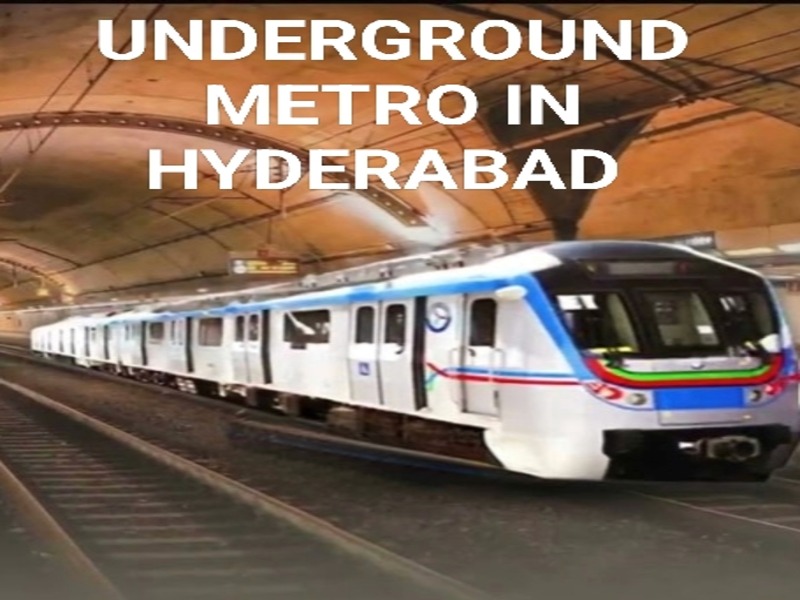Hyderabad Metro’s ambitious expansion includes underground marvels that promise to redefine urban transit. With new tunnels and stations beneath the city’s bustling streets, the project aims to ease traffic congestion and provide faster, more efficient commuting options. This expansion symbolizes Hyderabad’s leap towards a modern, sustainable urban future.
The proposed Hyderabad Metro route to the Rajiv Gandhi International Airport in Shamshabad is set to be a blend of unique features, marking a significant leap in the city’s metro infrastructure. Unlike the first phase, which predominantly consisted of elevated tracks, the new extension will introduce ground-level and underground segments, setting a new benchmark in urban transit within Hyderabad.
Metro Extension
The second phase of the Hyderabad Metro will extend the current line from Rayadurg to Nagole, stretching it further to LB Nagar, Chandrayangutta, Mailardevpally, Jalpally, P7 Road, and finally to the Shamshabad Airport. This new stretch will cover a distance of 33.1 kilometers.
Out of this, a 21.4-kilometer section from Nagole to Lakshmiguda will continue as an elevated route. However, from Lakshmiguda to the P7 Road, spanning 5.28 kilometers, the Metro will run at ground level. The decision to include ground-level tracks was taken after the Chief Minister, K. Chandrasekhar Rao, suggested that this could reduce construction costs. After a preliminary study, it was decided to incorporate this ground-level section into the Detailed Project Report (DPR).
The most innovative part of this project is the 6.42-kilometer underground stretch from the airport’s boundary to the terminal. This segment will be the first underground Metro route in Hyderabad, featuring three stations: Cargo, Terminal, and Aerocity, where a new depot is also proposed.
Every 1.5 Kilometers a station
On average, a Metro station will be available every 1.5 kilometers from Nagole to Shamshabad Airport, totaling 22 stations. Some of these stations are being planned as “future stations” to meet the city’s growing needs. Key interchange stations will be established in areas like Nagole, LB Nagar, Chandrayangutta, and Mailardevpally, ensuring seamless connectivity across the network. The DPR, which is already in place, will undergo necessary modifications if required.
Land Acquisitions
According to the preliminary DPR, Hyderabad Airport Metro Limited (HAML) has already identified the properties that need to be acquired along the airport corridor. Drawing from past experiences, HAML is working to complete the land acquisition process by the time the central and state governments approve the DPR and call for tenders.
In alignment with the 2013 Central Land Acquisition Act, the Hyderabad District Collector issued notifications on August 3rd, allowing 60 days for raising objections. Based on the identification of properties, HAML will continue to issue such notifications as the project progresses.
Modern Transit Innovations
The expansion of the Hyderabad Metro to Shamshabad Airport is not just an extension of the city’s transit system but a monumental leap in urban infrastructure. This project exemplifies a blend of sky-bound, ground-level, and subterranean transport systems, making it a distinctive addition to Hyderabad’s metropolitan landscape.
This extension of the Metro will play a crucial role in reducing traffic congestion, offering a faster, more efficient alternative to road travel, particularly for airport commuters. The strategic planning of stations and the innovative mix of elevated, ground-level, and underground tracks are designed to meet the city’s future transit needs while optimizing construction costs and minimizing disruption to existing urban infrastructure.
As Hyderabad continues to grow as a major urban center, the expanded Metro line will not only ease the daily commute for thousands but will also contribute to the city’s development, enhancing its status as a smart city with a world-class public transportation system.
The Hyderabad Metro’s Phase 2 is not just a transportation project but a forward-thinking solution that combines technology, urban planning, and sustainable development, setting the stage for the future of urban transit in India. #hydkhabar

